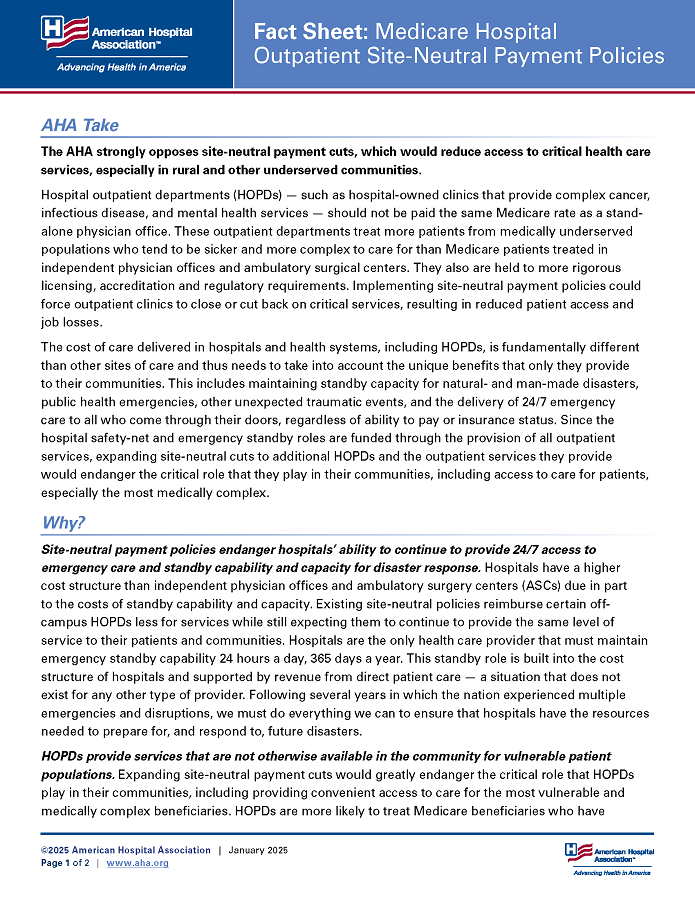

Fact Sheet: Medicare Hospital Outpatient Site-Neutral Payment Policies
Updated January 2025
AHA Take
The AHA strongly opposes site-neutral payment cuts, which would reduce access to critical health care services, especially in rural and other underserved communities.
Hospital outpatient departments (HOPDs) — such as hospital-owned clinics that provide complex cancer, infectious disease, and mental health services — should not be paid the same Medicare rate as a standalone physician office. These outpatient departments treat more patients from medically underserved populations who tend to be sicker and more complex to care for than Medicare patients treated in independent physician offices and ambulatory surgical centers. They also are held to more rigorous licensing, accreditation and regulatory requirements. Implementing site-neutral payment policies could force outpatient clinics to close or cut back on critical services, resulting in reduced patient access and job losses.
The cost of care delivered in hospitals and health systems, including HOPDs, is fundamentally different than other sites of care and thus needs to take into account the unique benefits that only they provide to their communities. This includes maintaining standby capacity for natural- and man-made disasters, public health emergencies, other unexpected traumatic events, and the delivery of 24/7 emergency care to all who come through their doors, regardless of ability to pay or insurance status. Since the hospital safety-net and emergency standby roles are funded through the provision of all outpatient services, expanding site-neutral cuts to additional HOPDs and the outpatient services they provide would endanger the critical role that they play in their communities, including access to care for patients, especially the most medically complex.
Why?
Site-neutral payment policies endanger hospitals’ ability to continue to provide 24/7 access to emergency care and standby capability and capacity for disaster response.
Hospitals have a higher cost structure than independent physician offices and ambulatory surgery centers (ASCs) due in part to the costs of standby capability and capacity. Existing site-neutral policies reimburse certain offcampus HOPDs less for services while still expecting them to continue to provide the same level of service to their patients and communities. Hospitals are the only health care provider that must maintain emergency standby capability 24 hours a day, 365 days a year. This standby role is built into the cost structure of hospitals and supported by revenue from direct patient care — a situation that does not exist for any other type of provider. Following several years in which the nation experienced multiple emergencies and disruptions, we must do everything we can to ensure that hospitals have the resources needed to prepare for, and respond to, future disasters.
HOPDs provide services that are not otherwise available in the community for vulnerable patient populations.
Expanding site-neutral payment cuts would greatly endanger the critical role that HOPDs play in their communities, including providing convenient access to care for the most vulnerable and medically complex beneficiaries. HOPDs are more likely to treat Medicare beneficiaries who have both more chronic conditions and more severe chronic conditions; are dually eligible for Medicare and Medicaid; are more likely to have a prior hospitalization and higher prior emergency department (ED) use; and are more likely to live in communities with lower incomes.1 This is especially true in rural areas. Medicare beneficiaries in rural communities disproportionately rely on HOPDs to meet their increased health care needs. The more rural the county that a beneficiary lives in, the more likely it is that their visits will take place in an HOPD rather than a physician office.1
HOPDs have more comprehensive licensing, accreditation and regulatory requirements than independent physician offices and ASCs.
Hospitals’ safety net roles means that they also are subject to more comprehensive licensing, accreditation and regulatory requirements than other settings. This includes the Emergency Medical Treatment and Labor Act (EMTALA), stricter requirements for disaster preparedness and response, stringent ventilation and infection control codes, quality assurance, accreditation, and fire and life safety codes. Site-neutral payment policies fail to account for these fundamental differences between hospitals and other sites of ambulatory care.
Medicare already pays substantially less than the cost of caring for its beneficiaries.
Medicare significantly underpays hospitals for the cost of providing care to patients. On average, Medicare pays only 82 cents for every dollar of hospital care provided to Medicare patients, leaving hospitals with $100 billion in annual Medicare shortfalls. As a result, two-thirds of all hospitals report negative Medicare margins.2 Additional site-neutral cuts will only exacerbate these shortfalls and reduce access to care for seniors.
The AHA strongly opposes any further site-neutral payment cuts, which threaten access to care. Treating services as the same regardless of the site of care ignores the fact that only certain providers are capable of caring for the most acute and vulnerable — and therefore resource- intensive — patients. In addition, these same providers are the sole source of a wide range of high-acuity essential services, such as emergency and trauma care, the costs for which must be shared across all services.


